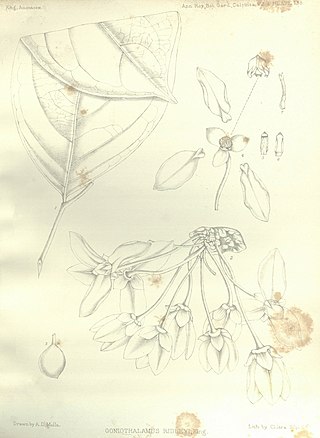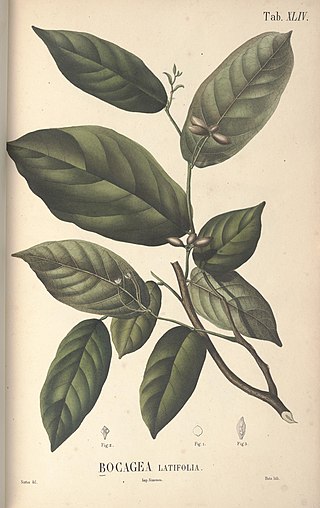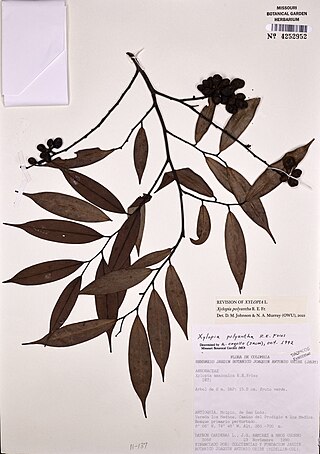
Annona sericea is a species of plant in the family Annonaceae. It is native to Bolivia, Brazil, Colombia, French Guiana, Guyana, Suriname, Trinidad-Tobago and Venezuela. Michel Félix Dunal, the French botanist who first formally described the species, named it after the silky hairs on its branches and leaves. In Brazil its common name is Aratincum do Para.
Annona acutiflora is a species of plant in the Annonaceae family. It is native to Brazil. Carl Friedrich Philipp von Martius, the German botanist who first formally described the species, named it after the inner petals which come to a sharp point.

Annona crassivenia is a species of plant in the family Annonaceae. It is native to Cuba. William Edwin Safford, the American botanist who first formally described the species, named it after the thick tertiary veins that interconnect the secondary veins of its leaves.

Annona paludosa is a species of plant in the family Annonaceae. It is native to Brazil, French Guiana, Guyana, Suriname and Venezuela. Jean Baptiste Christophore Fusée Aublet, the French pharmacist and botanist who first formally described the species, named it after its swampy habitat.
Bocagea longepedunculata is a species of plant in the family Annonaceae. It is native to Brazil. Carl Friedrich Philipp von Martius, the German botanist and explorer who first formally described the species, named it after its long floral stalks.
Fusaea peruviana is a species of plant in the family Annonaceae. It is native to Brazil, Colombia, Ecuador and Peru. Robert Elias Fries, the Swedish botanist who first formally described the species, named it after Peru where the specimen he examined was found near the Huallaga River and the city of Yurimaguas.
Goniothalamus aurantiacus is a species of plant in the family Annonaceae. It is native to Thailand. Piya Chalermglin and Richard M.K. Saunders, the botanists who first formally described the species, named it after its orange colored inner petals.
Goniothalamus latestigma is a species of plant in the family Annonaceae. It is native to Myanmar and Thailand. Cecil Ernest Claude Fischer, the botanist who first formally described the species, named it after its broad stigmas.
Goniothalamus puncticulifolius is a species of plant in the family Annonaceae. It is native to Borneo and The Philippines. Elmer Drew Merrill, the American botanist who first formally described the species, named it after its minutely spotted leaves.

Goniothalamus ridleyi is a species of plant in the family Annonaceae. It is native to Borneo, Peninsular Malaysia, Sumatra and Thailand. George King, who first formally described the species, named it after the English botanist Henry Nicholas Ridley who collected the specimen King examined.
Goniothalamus rongklanus is a species of plant in the family Annonaceae. It is native to Thailand. Richard Saunders and Piya Chalermglin first formally described the species and named it after Phu Hin Rong Kla National Park in Thailand.
Goniothalamus tortilipetalus is a species of plant in the family Annonaceae. It is native to Peninsular Malaysia and Thailand. Murray Ross Henderson, the Scottish botanist who first formally described the species, named it after its twisted petals.
Huberantha flava is a species of plant in the family Annonaceae. It is native to The Philippines. Elmer Drew Merrill the American botanist who first formally described the species, using the basionym Polyalthia flava, named it after its brilliant yellow flowers.
Monodora crispata is a species of plant in the family Annonaceae. It is native to Cameroon, Equatorial Guinea, Gabon, Ghana, Guinea, Ivory Coast, Liberia, Nigeria, and Sierra Leone. Heinrich Gustav Adolf Engler, the German botanist who first formally described the species, named it after its curled petal margins.

Monodora tenuifolia is a species of plant in the family Annonaceae. It is native to equatorial Africa. George Bentham, the English botanist who first formally described the species, named it after its slender leaves.
Duckeanthus is a genus of plant in the family Annonaceae. It is native to Brazil. It contains a single species, Duckeanthus grandiflorus. Robert Elias Fries, the Swedish botanist who first formally described it, named it in honor of Adolpho Ducke who collected the specimen he examined, and its large flowers.

Pseuduvaria latifolia is a species of plant in the family Annonaceae. It is native to Java. Carl Ludwig Blume, the German botanists who first formally described the species using the synonym Bocagea latifolia, named it after its broad leaves.

Uvariastrum insculptum is a species of plant in the Annonaceae. It is native to Cameroon, Gabon, Ghana, Ivory Coast, Liberia, Nigeria, and the Republic of the Congo. Adolf Engler and Ludwig Diels, the botanists who first formally described the species using the basionym Uvaria insculpta, named it after the secondary veins on its leaves which are distinctly sunken.

Xylopia calophylla is a species of plant in the Annonaceae family. It is native to Bolivia, Brazil, Colombia, Ecuador, Peru and Venezuela. Robert Elias Fries, the botanist who first formally described the species, named it after its beautiful leaves.

Xylopia polyantha is a species of plant in the Annonaceae family. It is native to Bolivia, Brazil, Colombia, Ecuador, and Peru. Robert Elias Fries, the botanist who first formally described the species, named it after its many flowers.









